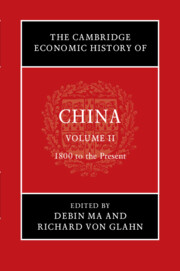Book contents
- The Cambridge Economic History of China
- The Cambridge Economic History of China
- The Cambridge Economic History of China
- Copyright page
- Contents
- Figures
- Maps
- Tables
- Contributors to Volume II
- Acknowledgments
- Note on Citations
- Introduction to Volume II
- Part I 1800–1950
- Part II 1950 to the Present
- 15 The Origin of China’s Communist Institutions
- 16 China’s Struggle with the Soviet Growth Model, 1949–1978
- 17 Living Standards in Maoist China
- 18 The Political Economy of China’s Great Leap Famine
- 19 China’s External Economic Relations during the Mao Era
- 20 The Chinese Economy in the Reform Era
- 21 China’s Great Boom as a Historical Process
- Index
- References
20 - The Chinese Economy in the Reform Era
from Part II - 1950 to the Present
Published online by Cambridge University Press: 07 February 2022
- The Cambridge Economic History of China
- The Cambridge Economic History of China
- The Cambridge Economic History of China
- Copyright page
- Contents
- Figures
- Maps
- Tables
- Contributors to Volume II
- Acknowledgments
- Note on Citations
- Introduction to Volume II
- Part I 1800–1950
- Part II 1950 to the Present
- 15 The Origin of China’s Communist Institutions
- 16 China’s Struggle with the Soviet Growth Model, 1949–1978
- 17 Living Standards in Maoist China
- 18 The Political Economy of China’s Great Leap Famine
- 19 China’s External Economic Relations during the Mao Era
- 20 The Chinese Economy in the Reform Era
- 21 China’s Great Boom as a Historical Process
- Index
- References
Summary
December 1978 was a political, economic and social turning point for China. As the balance of power within the top leadership shifted, a search for new policies began that deepened into what came to be called “reform and opening” and culminated decades later in a multistranded transition to a market-based economy. This new policy orientation was accompanied by a shift in development strategy that permitted China to take advantage of its factor endowments and structural conditions and dramatically accelerate economic growth. Thus 1978 marks not only the beginning of “reform,” but also the start of the Chinese “economic miracle,” a remarkable thirty-two-year period, through 2010, during which GDP grew at an annual rate of 10 percent. Chinese economic structure and Chinese society were utterly transformed. An extraordinary distance separates the vibrant upper-middle-income, predominantly market-based, economy that is China today from the troubled, isolated low-income country that was China at the end of the Cultural Revolution. This chapter builds its narrative around the systemic and structural changes that transformed China, especially in the thirty years between 1978 and 2008.
Keywords
- Type
- Chapter
- Information
- The Cambridge Economic History of China , pp. 722 - 774Publisher: Cambridge University PressPrint publication year: 2022
References
Further Reading
- 2
- Cited by

